update_recordset vendtable
setting DlvTerm = 'Cash'
where vendtable.vendgroup = 'Employee'
You are a Dynamics 365 Finance developer.
You have a table named FMVehicle that contains a field named VehicleId. The table has an index named VehicleIdIdx on the VehicleId field. You declare a table buffer named vehicle to refer to the table.
You need to select all records from the FMVehicle table in ascending order based on VehicleId field in the vehicle variable.
Which embedded-SQL statement should you use?
a
Produces all records in ascending order (though only the VecicleID field will be displayed).
Incorrect:
Not B, Not D: select vehicle index is not the correct SQL syntax.
Not C: must sort ascending, not descending
An organization has 1,000 vendors that are part of a vendor group named Employee. You have a field named DlvTerm that is used to describe the delivery terms for a vendor.
You need to set the value of DlvTerm to Cash for all vendors in the vendor group. You must update all vendor records in the vendor group as a single bulk operation.
Which two code segments can you use? Each correct answer presents a complete solution.
NOTE: Each correct selection is worth one point.
bc
update_recordset vendtable
setting DlvTerm = 'Cash'
where vendtable.vendgroup = 'Employee'
Thanks for submitting , your comment will be approved soon by our moderators
You need to prepare to deploy a software deployable package to a test environment.
What should you do to prepare?
a
DRAG DROP You are a Dynamics 365 Finance developer.
You need to troubleshoot performance issues for a client.
Which Lifecycle Services (LCS) tools should you use for each environment? To answer, drag the appropriate environment types to the correct tools. Each environment type may be used once, more than once, or not at all. You may need to drag the split bar between panes scroll to view content.
NOTE: Each correct selection is worth one point.
Select and Place:

Box 1: User Acceptance Testing (UAT) and Build
Box 2: User Acceptance Testing (UAT) Only
Not all environments contain all the tools. The following table shows the tools that are available for each type of environment.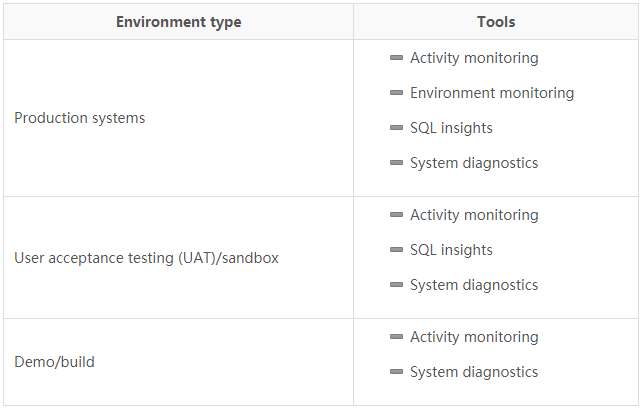
Box 3: Build only -
Reference:
http://axhelper.com/?p=16527
You are developing a model extension for Dynamics 365 Finance that extends objects from the Application Foundation package.
You need to create and configure a new model for the extension.
Which two actions should you perform? Each correct answer presents part of the solution.
NOTE: Each correct selection is worth one point.
ad
A: You must create a class.
D: Extension lets you extend existing artifacts in a new model.
A model that contains only extension customizations can be compiled into its own assembly and be deployed in its own package.
Reference:
https://docs.microsoft.com/en-us/dynamics365/fin-ops-core/dev-itpro/extensibility/class-extensions https://docs.microsoft.com/en-us/dynamics365/fin-ops-core/dev-itpro/dev-tools/model-split
DRAG DROP You create a Visual Studio project named ProductUpdates.
You must update data in a table named ProductTable. You must be able to run the code from Visual Studio.
You need to create an X++ class.
Which four actions should you perform in sequence? To answer, move the appropriate actions from the list of actions to the answer area and arrange them in the correct order.
Select and Place: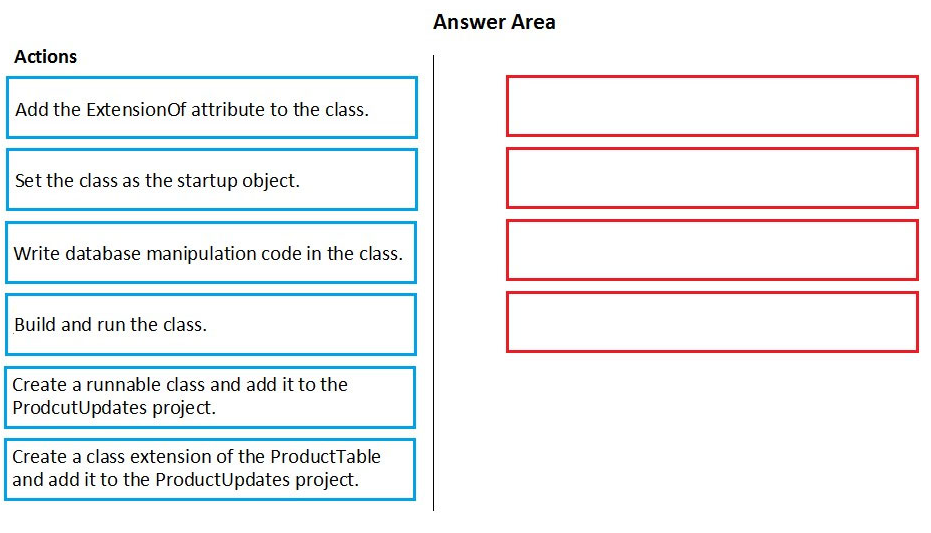
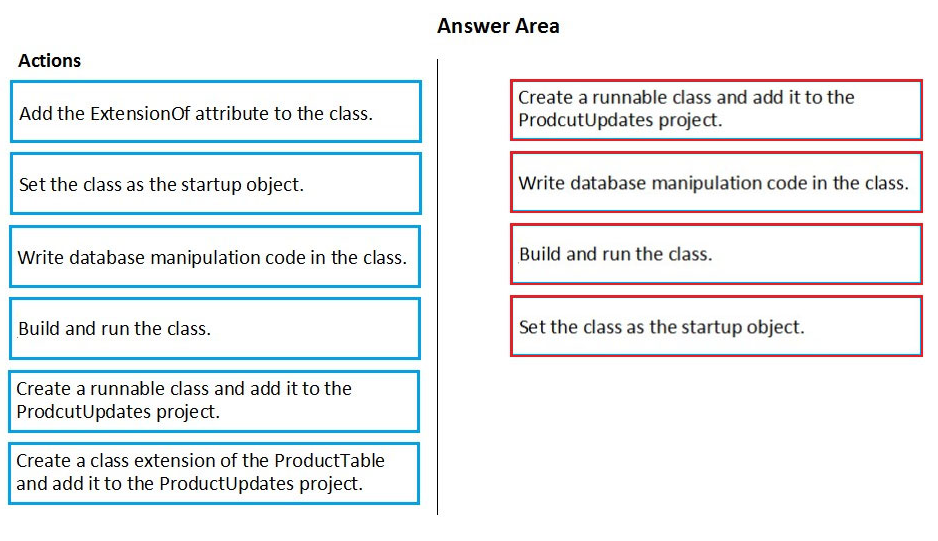
Reference:
https://community.dynamics.com/365/financeandoperations/b/daxology/posts/runnable-class
You are working with extended data types in Visual Studio.
You need to create an extension of an Extended Data Types (EDT) that is derived from base data types.
Which three properties can be modified? Each correct answer presents a complete solution.
NOTE: Each correct selection is worth one point.
ace
String size can be defined only on root EDTs. The system will use the largest value that is defined across the EDT and its extensions.
Labels and Help text properties can be changed by an extension, but only one value can remain.
Reference:
https://docs.microsoft.com/en-us/dynamics365/fin-ops-core/dev-itpro/extensibility/extensible-edts
HOTSPOT You need to create the new table for the vendor exclusion list.
What should you do? To answer, select the appropriate options in the answer area.
NOTE: Each correct selection is worth one point.
Hot Area:

Scenario: You must develop a new solution to maintain a Vendor exclusion list for each customer and item combination. The solution must meet the following requirements:
Isolate all new vendor exclusion codes as a new assembly by creating a table named VendExclusions.
Create an index for the table named PrimaryIdx that uses the following fields: CustAccount, ItemId, VendAccount.
Ensure that users can open the Vendor Exclusion list report from the customer master form. The list must display the customer account, Item ID, and Vendor account fields.
Maintain referential integrity with other tables.
Box 1: a table extension for Vendors and relation for the Vendor exclusions
Box 2: RelationShip Type -
Reference:
https://docs.microsoft.com/en-us/dynamics365/fin-ops-core/dev-itpro/data-entities/develop-composite-data-entities
A company is implementing Dynamics 365 finance and operations apps.
The company must test its native Dynamics 365 finance and operations apps by using multiple values.
You need to create a test case within a development environment.
Which attribute should the test case use?
a
DRAG DROP You need to deploy the web portal integration solution.
Which four actions should you perform in sequence? To answer, move the appropriate actions from the list of actions to the answer area and arrange them in the correct order.
Select and Place: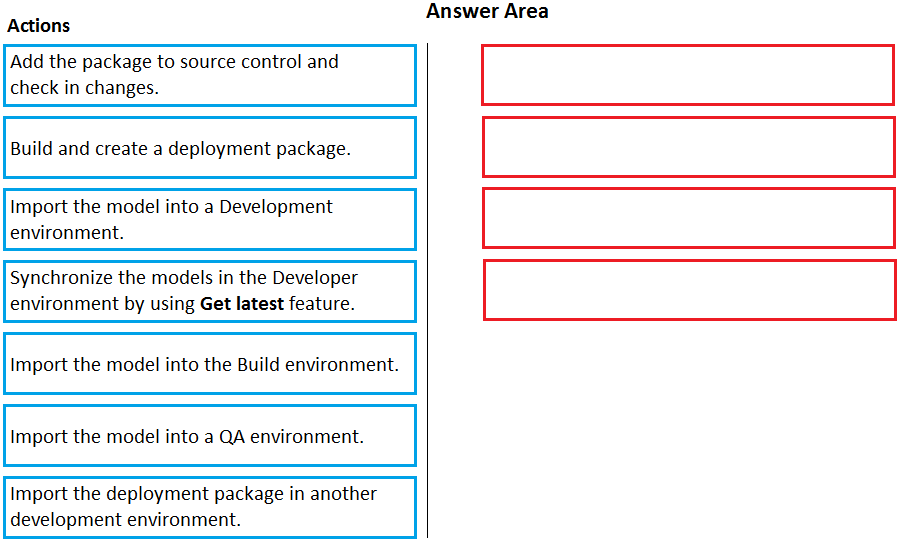
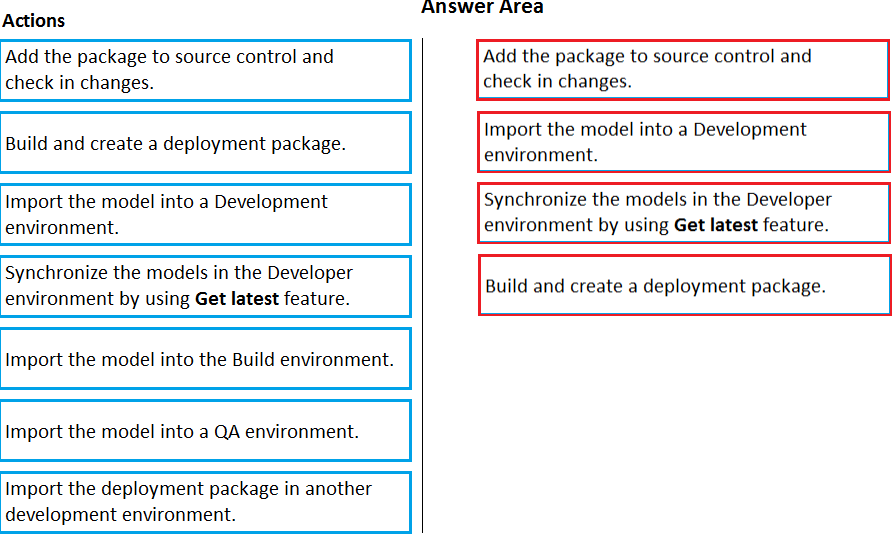
Scenario: You must install and configure a third-party solution for credit card processing within Dynamics 365 Finance. The third-party company will provide a deployable package.
You must develop a web portal that allows customers to browse products, place orders, and check order status. Product data for the web portal must be integrated as periodic batches.
You must configure the warehouse mobile device portal for warehouse operations.
You must install a third-party solution to support web portal integration. The solution is supplied as a source code model file.
Step 1: Add the package to source control and check in the changes.
Deployable packages from third parties can be manually installed on a development VM, and the installed artifacts can then be added to source control.
Step 2: Import the model into a Development environment.
Install a model in a development environment
Step 3: Synchronize the models in the Developer environment by using Get latest feature
Because the models and runtime packages are in source control, other developers who use other development environments can just synchronize the models and packages to their workspace by using the Get latest feature of source control.
Step 4: Build and create a deployment package
The build process will include this runtime package in the final deployable package. This allows customers to take the deployable package from the build and have one package to deploy to their environments. The one package includes both custom solutions and all the third party solutions.
Reference:
https://docs.microsoft.com/en-us/dynamics365/fin-ops-core/dev-itpro/dev-tools/manage-runtime-packages https://docs.microsoft.com/en-us/dynamics365/fin-ops-core/dev-itpro/dev-tools/manage-runtime-packages#deploying-third-party-code